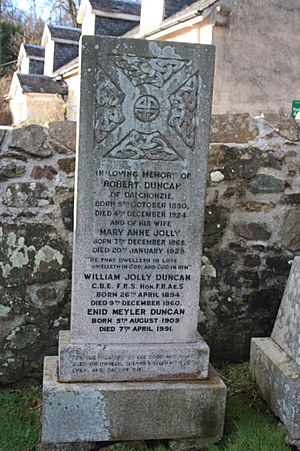William Jolly Duncan facts for kids
William Jolly Duncan (born April 26, 1894, died December 9, 1960) was a Scottish scientist. He was a key figure in the 20th century, known for his work on making airplanes safer. He was a pioneer in the study of aeroelasticity and "air flutter." These are ideas about how aircraft parts bend and twist when air pushes on them, which is crucial for modern aviation.
Contents
Life of William Jolly Duncan
William Jolly Duncan was born in Govan, Scotland, on April 26, 1894. He was the only son of Robert Duncan, an engineer, and Mary Ann Jolly.
Early Education and War Service
William first went to Allan Glen's School in Glasgow. Later, when his father became a Member of Parliament (MP) for Govan, William went to boarding school in England. He studied at Dulwich College and then went on to study Engineering at University College, London.
When the First World War started in 1914, William joined the army. He served in France and Flanders. In 1916, he returned to Britain to use his engineering skills. He worked for the Aeronautical Inspection Unit, helping with aircraft production for the war effort.
Career in Aviation Science
After the war, William worked for his family's engineering company for a short time. However, he was more interested in aviation. In 1926, he joined the Aerodynamics Department at the National Physical Laboratory. This is where he began his important work on how air affects planes.
In 1934, he became the first Professor of Aeronautics at University College Hull. During the Second World War, he worked with the Royal Aircraft Establishment. His work helped improve aircraft design and safety during this critical time. After the war, he became a professor at the College of Aeronautics, Cranfield.
In 1947, William Jolly Duncan was recognized for his amazing contributions to science. He was elected a Fellow of the Royal Society of London. This is a very high honor for scientists.
In 1950, he returned to his hometown of Glasgow. He became the Mechan Professor of Aeronautics and Fluid Mechanics at Glasgow University. He continued in this important role until he passed away.
Later Life and Legacy
William Jolly Duncan died on December 9, 1960, after an operation. He is buried with his parents at Old Logie Kirkyard, near Stirling. His work on aeroelasticity and air flutter helped make flying much safer and more efficient for everyone.
Family Life
In 1936, William Jolly Duncan married Enid Meyler Baker. Her father, G. S. Baker, also worked in science, at the William Froude Laboratory.


